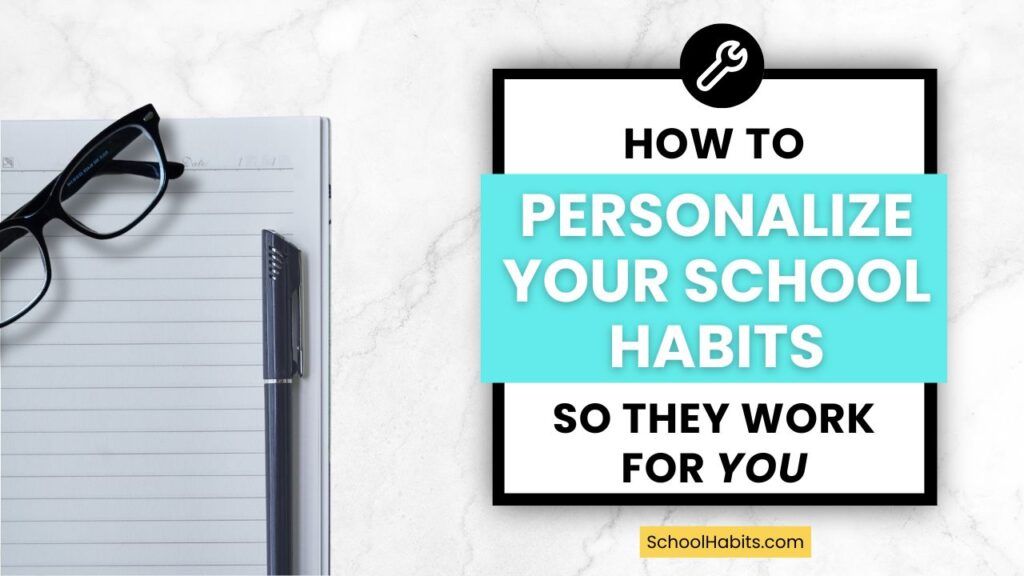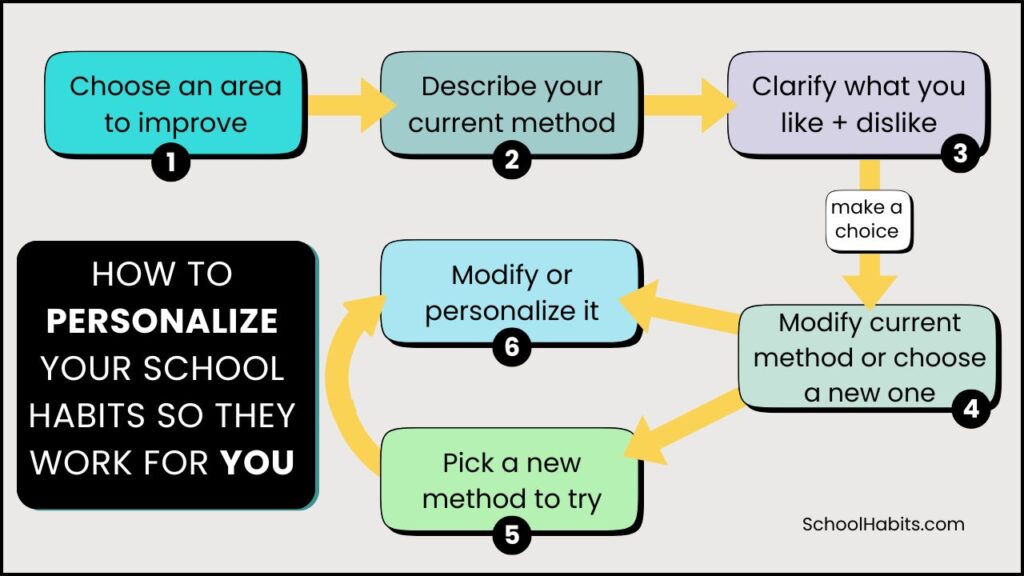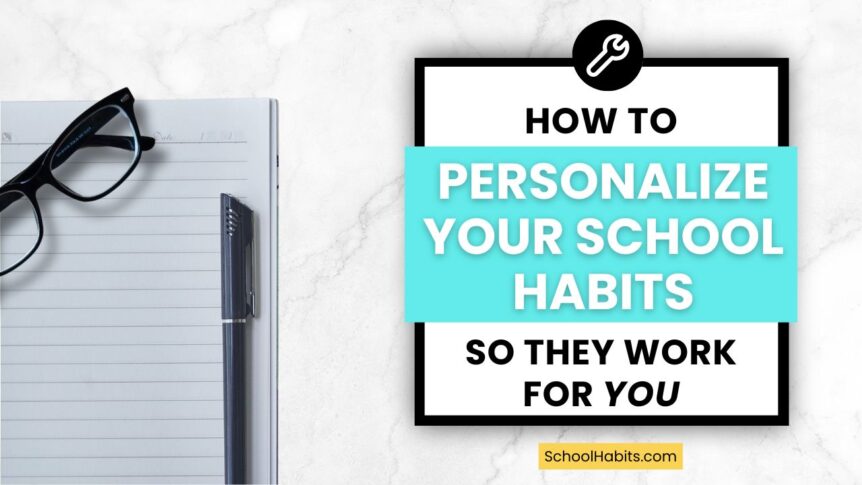
By Katie Azevedo, M.Ed.
Things I hear every week as an executive function/ADHD coach and study skills expert:
- “I’ve tried that study method, and it doesn’t work for me.”
- ”I try to get organized and I just can’t.”
- ”I tried taking notes like that but they didn’t work.”
I’ve created hundreds of school habits and study tutorials over the last decade. The study skills, time management methods, note-taking techniques and organizational systems I teach are based on 20 years of teaching experience and working with thousands of students — plus, a Master’s Degree in special education. But … even still, every strategy I teach comes with the caveat that students (you!) need to figure out what works for YOU.
Note-taking improves learning — but only if you’re taking notes in a way that works for YOU.
Calendar and homework trackers work — but only if you’re using them in a way that’s sustainable to YOU.
Active recall study methods are the most effective study methods that exist — but only if you’re using active recall study methods that work for YOU.
In this blog post, I teach you how to personalize your study skills and school habits so they work for you. You’ll learn how to determine what’s working and what’s not working, plus how to tweak the details while keeping the fundamentals.
How to Personalize Your Study Skills and School Habits so They Work for YOU
A note for students with ADHD: If you have ADHD, finding alternatives to “typical” study methods and school habits is essential if you want to succeed. If you find a method that works for you — even though it’s something I’ve never written or talked about — that’s great! Keep using it.
Step 1: Identify What Area You Want To Work On
You may know this from science, but it’s best to change just one variable at a time. In the context of improving your school habits or study skills, pick one area to start with.
You can download and use my free student self-assessment to identify your areas of strength and weakness. If you use the self-assessment, start with the area it identifies as needing the most improvement.
Or, you could consider starting with one of the following areas :
- Study strategies
- Time management
- Task management
- Note-taking
- Annotating
- Organization
(Interesting – those are also the 6 skills I teach extensively inside SchoolHabits University! winkwink)
Step 2: Get Clear on What You’re Currently Doing
Once you’ve picked an area to start with, it’s important to get clear about how you’re currently doing it.
We can’t personalize or customize a school habit or study strategy if we don’t first understand how we’ve been using/doing it up to this point. It’s safe to assume that what you’ve been doing hasn’t been working for you, which is why you’re here learning how to personalize it – but the real question is: what are you currently doing?
In other words, try to name your current method.
IMPORTANT NOTE: If you think you’re following a study method or school habit that has a “name” to it, like the Feynman Technique, the Blurting Method, Cornell notes, etc., it’s suuuper important that you’re suuuper sure you’re following that method correctly. Before you go any further, make sure you research the method and check that against what you’re doing. If there’s no name for what you’re currently doing, you’re fine to proceed.
Example A: You’ve been struggling to figure out a note-taking system that works for you. You heard people talk about how great Cornell notes are, so that’s what you’ve been trying to use. But you don’t love it.
Example B: You’ve been struggling on tests and quizzes and you’re trying to find a study method that works for you. You’ve been making flashcards to study because you know flashcards are supposed to be helpful, but your grades are still not the best.
Step 3: Get Clear About What Works and Doesn’t Work About Your Current Strategy
Think about what you like about your current strategy. Are there any parts of it that do work? Where can see the value?
Now, think about what you don’t like about your current strategy. What parts of it are annoying or incompatible with your schedule, how you think, or your personal preferences? What would you change if you could?
Example A: You like that your Cornell notes are easy to study from because they’re split into two columns, but you dislike the summary box you have to write at the bottom of each page.
Example B: You like studying from flashcards but you don’t like how long they take to write out.
Important Note: Here are the top 10 “good” school habits that seem smart but are actually bad. When you’re done reading this post, I strongly suggest checking that list and making sure you’re not falling for one of those “good” school habits.
Step 4: Decide If You Want to CHANGE or PERSONALIZE Your Strategy
Based on your answer to Step 3, you have a choice to make: You can either change your strategy entirely, or you can modify or personalize your strategy slightly so it works better for you.
If you want to change your method entirely, process to Step 5.
If you want to personalize or modify what you’re currently doing, proceed to Step 6.
Example A: You decide you want to try a different note-taking method besides Cornell Notes.
Example B: You like flashcards, so you just want to find a way to personalize the strategy so they work better for you.
Step 5: Pick a New LEGITIMATE Strategy
Do your research to find another strategy for the area you’re working on. You can use any of my resources on this blog post or my YouTube channel. Or Google it. You can even ask your friends what they do. Regardless of what method you settle on, make sure you fully understand the strategy and how it works.
Next, you’re going to try your new method for two weeks. It’s important to give it this long so you can see how it works on good days and bad days. You may find it helpful to use a habit tracker to stay accountable.
After two weeks, evaluate the strategy. What didn’t you like? What did you like? Where were the friction points? This is similar to the process you followed in Step 3.
If your new strategy is working, that’s great – keep using it! If not, proceed to Step 6 for How to personalize it.
Example A: You did your research and discovered 2-column notes. This sounds more appealing than Cornell notes because you don’t have to write the summary box on each page.
Step 6: Modify or Personalize Your Study Skill or School Habit so It Works for You
You may arrive at this step directly after Step 4, or perhaps after trying an entirely new strategy for two weeks (Step 5). Regardless, if you want to keep using a particular strategy while personalizing it to make it work better for YOU, consider making any of the following tweaks (I suggest making one tweak at a time).
Tip: Try your modification for at least a week and then re-evaluate. Repeat if necessary.
8 Ways to Modify and Personalize a Strategy so It Works Better for YOU (with Examples!):
- Do it longer – Ex: Extend your Pomodoro sessions from 25 minutes to 45 minutes
- Do it shorter – Ex: Reduce your study sessions from one 60-minute session to two 30-minute blocks
- Switch from analog to digital or vice versa – Ex: start taking digital notes with a stylus and tablet instead of hand-writing notes on paper (Here are the pros and cons of digital vs. paper notes)
- Do it on a different day or different time of day – Ex: Do your “Sunday Routine” on Friday afternoons
- Add or remove something – Ex: Start or stop color-coding your notes
- Change your location – Ex: Study in a library instead of in the student center
- Change your materials – Ex: Use higher quality notebook paper and pens
- Do it with someone else – Ex: Schedule some group study sessions
Example B: You liked studying from flashcards but you didn’t like how long they took to write out. So you modify/personalize your strategy by writing out your flashcards gradually, from the very first day of each unit. You slowly build a pile of flashcards over days/weeks, so you feel less stressed when it’s time to begin studying.
A note for students with ADHD: You may want to play with some of these modifications if you begin to get bored with your current study methods or habits. Even if your methods previously worked for you, they can stop working if they’re no longer stimulating — so feel free to modify your methods with any of the above ideas whenever you need a change.

4 Additional Tips to Personalize Your Study Skills and School Habits So They Work Better:
Keep in mind the following warnings and best practices to improve your chances of successfully personalizing your school habits and study strategies.
- Consider your emotional state – is the habit really not working or are you particularly stressed or sad?
- Consider your schedule – don’t plan to experiment with your habits or strategies over a vacation or extended break.
- It’s okay if you fall off the bandwagon. Just be sure to name that for what it is and not blame the strategy. For example, if you skip a few days of using your strategy because you’re stressed, acknowledge your stress, forgive yourself, and move forward.
- Be careful to avoid “bright shiny object syndrome” (always chasing something new and “exciting”) and believing what you see on social media. Implementing good habits and knowing how to personalize them to work better for you takes EFFORT. None of this is easy, despite the appeal of “study hacks” and superficial claims that it’s possible to change overnight.

